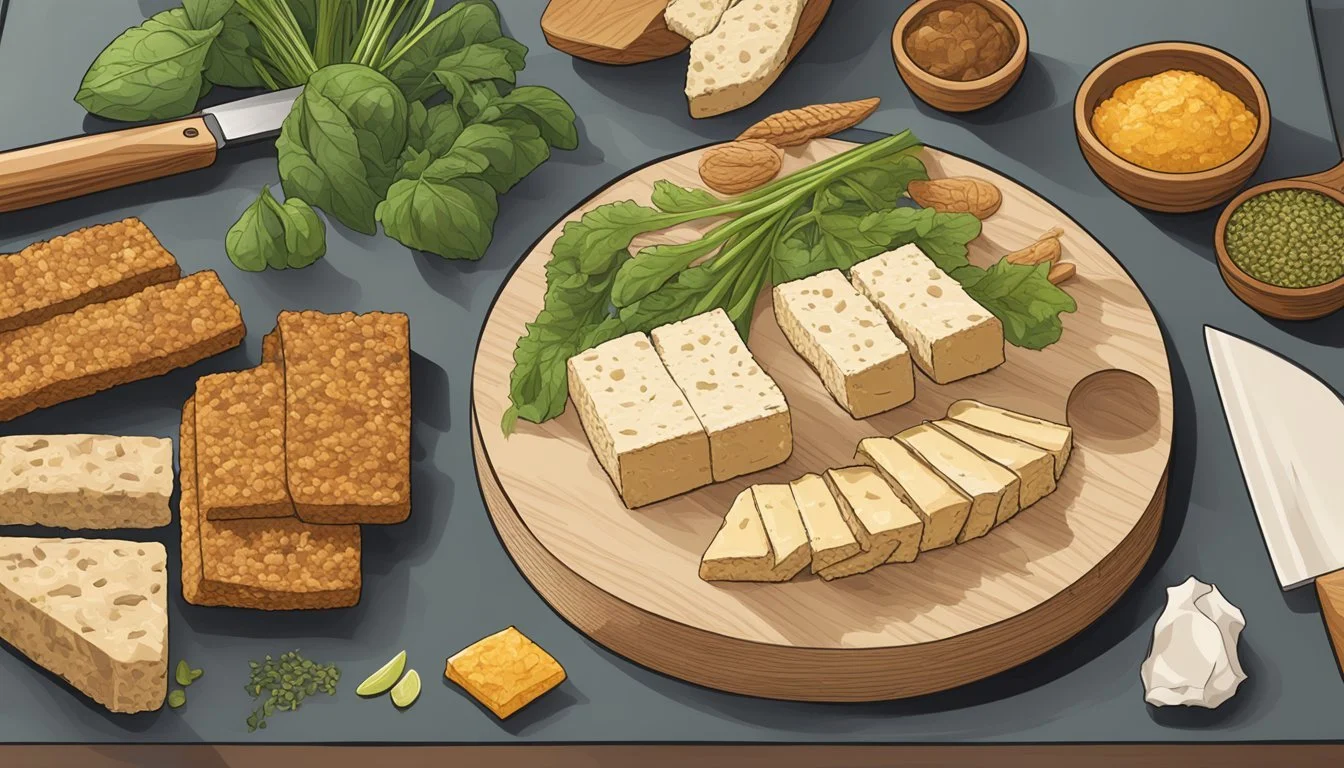Savory Substitutes
Delicious Alternatives for Your Favorite Ingredients
Savory, a key herb in many traditional recipes, brings a distinctive flavor that can enhance a plethora of dishes. Yet, there are moments when this ingredient is unavailable, and knowing suitable substitutes can be invaluable for any home cook. Basil, for instance, can replace savory in a 1:1 ratio, providing a mild sweetness that complements many dishes.
Dried thyme is another excellent alternative, sharing a similar robust flavor profile to savory. It fits seamlessly into vegetable recipes, meat dishes, stews, soups, and marinades. The accessibility of thyme makes it a practical substitute for those times when savory isn't on hand.
For those looking to explore beyond the usual herb cabinet, options like dill, marjoram, and oregano offer unique, flavorful alternatives. Oregano, with its aromatic and slightly bitter taste, pairs well in tomato-based sauces, baked vegetables, and pizza. These substitutions ensure your dish remains flavorful and satisfying, even without the original ingredient.
Fundamentals of Savory
Savory is a versatile herb known for its earthy, peppery flavor, widely used in a variety of culinary dishes. Different types of savory, including summer and winter varieties, each have unique characteristics and uses.
What Is Savory?
Savory is an herb belonging to the mint family. It is widely used for its robust, earthy, and peppery flavor. Savory is commonly found in Mediterranean cuisine and is a staple in herb blends such as Herbes de Provence.
Both fresh and dried forms are used in cooking. Fresh savory is often added toward the end of the cooking process to maintain its flavor. Dried savory has a more concentrated taste and can be added earlier in the cooking process.
Types of Savory
Savory comes in two main varieties: summer savory and winter savory. Summer savory is an annual plant that has a milder, sweeter flavor. It is typically used fresh in dishes like beans, vegetables, and poultry.
Winter savory is a perennial plant. Known for its stronger, more pungent flavor, it is often used in heartier dishes such as stews and roasts. Both types of savory add a complex, aromatic quality to various recipes.
Summer Savory Vs. Winter Savory
Summer savory (Satureja hortensis) and winter savory (Satureja montana) differ in flavor, growth habits, and culinary uses. Summer savory is less intense and grows as an annual plant. It is a favorite in lighter dishes due to its delicate taste.
Winter savory, with its robust and peppery flavor, is best suited for slow-cooked and hearty meals. As a perennial, it offers year-round availability. Gardeners value it for its hardiness and prolonged yield.
Culinary Uses of Savory
Savory is a versatile herb that enhances various dishes, from complex herb blends to straightforward meat and vegetable recipes. Its robust flavor pairs well with other Mediterranean and European seasonings.
Savory in Herb Blends
Savory is a key ingredient in numerous classic herb blends, enriching their complexity. In Herbes de Provence, it complements lavender, rosemary, and thyme, crucial in French cooking for seasoning meats, stews, and grilled vegetables.
Italian cuisine also incorporates savory in many regional spice mixes, providing a peppery touch that harmonizes with oregano and basil. These herb blends are fundamental in Mediterranean dishes, balancing flavors in soups, sauces, and baked goods.
Role in Meat Dishes
Savory brings out the best in various meat dishes. Its strong, peppery flavor enhances roasted, grilled, and braised meats, making it a staple in many cooking methods.
In French and Mediterranean cooking, savory is often used to season lamb, pork, and poultry. It works well in marinades and rubs, imbuing meats with a depth of flavor during the cooking process. When combined with garlic and other herbs, savory creates a robust seasoning perfect for hearty meat dishes.
Adding Flavor to Vegetables
Vegetables benefit significantly from the addition of savory, which can transform ordinary produce into flavorful, aromatic dishes. When used in salads, soups, and stews, savory imparts a savory note that enhances the natural flavors of various vegetables.
Savory is particularly effective in bean dishes. It not only adds flavor but also helps reduce the gas-inducing effects of beans. Potatoes, carrots, and other root vegetables are also elevated with this herb, making it a valuable addition in various culinary contexts.
Cooking with savory can involve sprinkling it on roasted vegetables or mixing it into dressings, ensuring a rich, earthy taste that complements the dish.
Selecting Savory Substitutes
When selecting substitutes for savory, consider factors such as taste profile matching and accessibility. Ensuring the substitute complements the dish and is readily available can significantly enhance the cooking experience.
Taste Profile Matching
In order to maintain the intended flavor of a dish, matching the taste profile of savory is essential. Savory herbs have a unique blend of peppery and aromatic qualities. Substitutes like thyme and oregano are effective due to their similar flavor profiles. Thyme offers a subtly peppery and fragrant taste, making it a perfect 1:1 replacement. Oregano, with its pungent and aromatic notes, is excellent in tomato-based sauces and Mediterranean dishes.
Using dill can provide an additional twist. Although not identical, dill’s distinct flavor can enhance sauces and salads. Similarly, rosemary presents a unique combination of pine, citrus, and peppery notes that closely mimic the savory herb’s profile. Each of these herbs offers a robust alternative that fits well in various recipes.
Accessibility and Availability
Accessibility and availability of substitutes are practical considerations. Commonly found herbs in most markets, such as thyme, oregano, and basil, make for easy substitutions. These herbs are straightforward to locate, whether fresh or dried, ensuring continuity in your cooking.
When choosing substitutes, utilizing Herbes de Provence is also advantageous. This blend of dried French herbs usually includes thyme, basil, and rosemary, ensuring a balanced flavor profile. Fresh basil, another widely available substitute, should be added towards the end of cooking to preserve its sweet and aromatic properties. Monitoring availability and opting for frequently stocked herbs will simplify the process of replacing savory in any recipe.
Substitutes for Specific Dishes
When seeking substitutes for savory seasoning, it's crucial to consider the dish type to ensure the alternative complements the other ingredients effectively. Each category, from soups to meat preparations, benefits from different herbs and spices.
Alternatives for Soups and Stews
For soups and stews, thyme stands out as a top choice owing to its aromatic and earthy qualities. Use thyme in a 1:1 ratio to replace savory seasoning. Oregano is another excellent substitute, especially in tomato-based broths, where its strong, pungent flavor can shine. Rosemary adds a piney, peppery note that enhances hearty stews. Fresh basil can also be used, but it should be added toward the end of cooking to preserve its delicate flavor.
Picking Substitutes for Meat Preparations
In meat preparations, both fresh and dried thyme offer a robust flavor profile similar to savory. Thyme's versatility makes it suitable for everything from beef stews to grilled pork. Rosemary works particularly well with lamb and beef, infusing dishes with a mild citrus and evergreen essence. Dill can serve as a savory substitute in meat rubs and marinades, providing a fresh, tangy touch ideal for Mediterranean-style dishes.
Substitutes in Vegetable Cookery
For vegetable cookery, oregano is a stellar substitute, bringing a slightly spicy and bitter taste that pairs well with baked or sautéed vegetables. Basil can be used in vegetable soups and roasted vegetables for a sweet and aromatic twist. Dried thyme helps maintain an earthy, savory note and blends nicely with a variety of vegetable preparations such as ratatouille or stuffed bell peppers.
Seasonings for Fish and Poultry
When seasoning fish and poultry, dill is invaluable for its fresh, lightly sweet flavor, which complements the mild taste of fish beautifully. Thyme is also a great alternative, especially for poultry dishes such as roasted chicken or turkey. Oregano works well with grilled fish, providing a robust herbal background. Rosemary can be used sparingly on fish and poultry to add a subtle pine and citrus hint.
Choosing the right substitute for savory in specific dishes enhances the overall dish, ensuring it remains flavorful and true to its intended profile.
Alternative Herbs and Spices
When you're out of savory or looking to experiment with new flavors, many herbs and spices can serve as effective alternatives. Below you'll find specific herbs and spice blends that can replace savory in your recipes.
Single Herb Options
Oregano – Known for its robust and slightly bitter taste, oregano is a popular substitute for savory. It's especially effective in Mediterranean dishes.
Thyme – A versatile herb with a mild, earthy flavor. Thyme can complement many recipes where savory would typically be used.
Marjoram – This herb has a sweet, delicate taste that can mimic the subtler notes of savory.
Sage – Pungent and aromatic, sage offers a stronger flavor profile. Use it sparingly to avoid overpowering your dish.
Rosemary – With its pine-like and citrus nuances, rosemary can add depth. It's potent, so start with small amounts.
Dill – Often used in Mediterranean cooking, dill provides a fresh, tangy flavor. It's less common but effective as a savory substitute.
Mint – While unconventional, mint can add a refreshing twist, especially in dishes that benefit from a lighter, more vibrant flavor.
Spice Blend Alternatives
Italian Seasoning – This blend typically includes oregano, basil, thyme, rosemary, and marjoram. It’s a well-rounded substitute that enhances a variety of dishes.
Herbes de Provence – A blend of herbs like thyme, marjoram, and rosemary, this mix can bring a similar complexity to your cooking.
Poultry Seasoning – Often containing sage, thyme, and marjoram, poultry seasoning is another versatile blend ideal for substituting savory.
Mixed Herbs – General mixed herb blends can vary but generally include thyme, rosemary, and oregano. They can serve as a quick and easy substitute.
Creating Custom Substitutes
To tailor a spice mix to match savory's flavor profile, combine specific herbs:
Thyme & Marjoram: Mix in equal parts to mimic savory's complexity.
Rosemary & Sage: Blend for a pungent, robust alternative.
Oregano & Basil: Use for a more Mediterranean-inspired substitute.
Adjust proportions based on the dish's requirements. For a sweeter profile, increase marjoram; for earthiness, add more thyme. Adding a hint of dill or mint can introduce unique, refreshing notes.
Effective substitution involves balancing flavors to suit individual preferences and the dish's requirements. Experimentation can often lead to delicious results.
Health Benefits and Nutrition
Savory and its substitutes provide numerous health benefits, such as boosting the immune system and improving digestion. They are rich in essential vitamins and minerals, and also possess significant medicinal properties.
Vitamins and Minerals
Savory herbs are rich in vitamins such as vitamins A, C, and K, which contribute to antioxidant activity and support immune system function. They also provide essential minerals like potassium and magnesium that help maintain healthy blood pressure levels and support muscle function.
Calcium present in these herbs is crucial for bone health, while iron aids in oxygen transport and reduces fatigue. Manganese and other trace elements are beneficial for enzyme function and overall metabolism.
Medicinal Properties
Savory herbs possess multiple medicinal properties, including anti-inflammatory effects, which help reduce inflammation and pain. Their antioxidant content aids in protecting cells from damage, potentially lowering cancer risk.
These herbs can enhance digestion and relieve gastrointestinal disorders like bloating and indigestion. They are often used as a tonic to stimulate appetite and improve nutritional intake. Additionally, compounds in savory herbs may improve cognitive function and offer protective benefits for the brain.
Regular use supports respiratory health and immune system enhancement, keeping common infections at bay.
Practical Cooking Tips
When substituting savory herbs in your recipes, it's crucial to get both the usage and the combination right to enhance your dishes' flavor and texture.
Correct Usage of Substitutes
Using substitutes for savory requires attention to the intensity and texture of the herb. For example, fresh basil should be added at the end of cooking to prevent flavor loss, typically used in a 1:1 ratio.
Dried thyme offers a richer taste and aroma, suitable for long-cooking recipes like stews, meats, and soups. It also complements vegetables well.
Oregano can be freshly used for long-cooking recipes or added to pizzas for an aromatic, pungent flavor. Dill is another flavorful alternative often used in Mediterranean dishes, replacing herbs like parsley or basil.
Combining Flavors and Textures
Combining herbs can create a balanced flavor profile. For example, rosemary with its distinct pine and citrus notes can pair well with lavender for a unique savory flavor.
Mixing different herbs like thyme and oregano can enhance both flavor intensity and texture. Epazote offers a strong, pungent taste that's different from earthy and bitter notes found in winter savory. It's also good to note the price differences for cost-effective substitutions: epazote tends to be pricier than winter savory.
Experimenting with combinations allows the creation of a desired flavor and texture profile that can elevate the dish, taking into account each herb's unique properties.
Elevating Recipes with Savory Substitutes
When replacing savory with other herbs, it's essential to focus on enhancing the dish's aroma and boosting its complexity.
Enhancing the Dish's Aroma
Substitutes like thyme and sage offer pungent and woody notes that can elevate the overall aroma of your dish. Thyme, known for its minty and citrusy scent, works well in stews and roasts, bringing a fresh and vibrant profile.
Sage provides an earthy and slightly bitter undertone, making it ideal for poultry and meat dishes. It's especially effective as a garnish or in stuffing. Using rosemary adds a pine flavor and garlic notes, perfect for lamb and roasted vegetables.
Boosting Umami and Complexity
Oregano and winter savory are excellent for adding a rich umami quality and complexity. Oregano, with its hot and spicy characteristic, complements tomato-based dishes and Mediterranean cuisine.
Winter savory, more bitter than summer savory, pairs well with legumes and grilled meats. Marjoram offers a milder, sweeter flavor, suitable for soups and sauces.
Herbes de Provence, a mixture including savory, thyme, rosemary, and others, imparts a complex combination of pungent, woody, and spicy notes, enhancing the depth of any dish.









